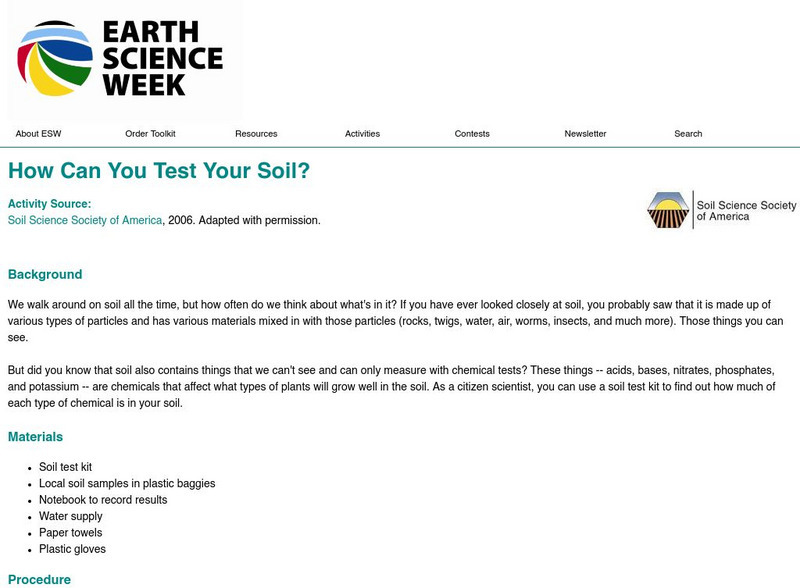Hi, what do you want to do?
Curated OER
Looking At Acid's Effects On Metals
Students perform an experiment that demonstrates acid rain. The chemical effect of acids on metals may take at least five days for the human eye to see, even though the reaction starts as soon as the acid contacts the metal.
Curated OER
School Site Ecosystem
Fourth graders are introduced to the concept of ecosystem; specifically, the interrelationships among plants and animals within an ecosystem, and their relationships to the environment in which they live and interact.
Curated OER
The Extraordinary Life of the Alaskan Tundra
Students investigate the characteristics of the tundra on the North Slope of Alaska. They conduct Internet research, develop a chart of the types of vegetation, plant growth, and fauna found on the tundra, identify examples in their own...
Curated OER
Earthquake!
Students gain an understanding of earthquakes. They examine vocabulary associated with earthquakes, how earthquakes happen, and preventive measures taken to diminish damage or harm in the event that an earthquake should happen.
Curated OER
Comets and Meteors
Students construct a model of a comet nucleus using dry ice. They add other materials and describe the features. They complete related exercises on an Internet Web site.
Curated OER
Earth's Atmosphere and Temperature
Learners explore the layers of earth's atmosphere and conduct an experiment to identify carbon dioxide. They construct models using styrofoam to represent molecules in the atmosphere's layers. To discover how sunlight efffects...
Curated OER
Ammonium Nitrate - Efficient Fertilizers
Learners study the chemistry of ammonium nitrate and consider the advantages and disadvantages of this compound. They compare different fertilizers and calculate the molar mass and percent nitrogen in the different fertilizers.
Curated OER
Map Reading
After examining a map from 1803 and 2003, they explore how to become map readers. They describe what they see on the map from 1803 and compare the information to the map from 2003. Students create their own map of the neighborhood that...
Curated OER
Google Earth Scavenger Hunt
Pupils complete activities to learn how to use Google Earth and study Alaska. For this Google Earth lesson, students complete a Google Earth scavenger hunt to find facts about Alaska. Pupils complete two worksheets for the topic.
Curated OER
Cupcake Core Sampling
Students discuss core samples. In this environment activity, students experiment discovering what is beneath the surface by using cupcakes as models finding out what sort of layers are found within the cupcakes.
Curated OER
Carnivorous Plants: A Bugs Nightmare!
Students research carnivorous plants and how they trap insects. They role play as botanists to write a research field guide about a newly discovered imaginary carnivorous plant.
Curated OER
Cavern Geology: Speleothem Construction
Students discover how underground rock formations grow. They perform various activities based on grade level.
Curated OER
Become a Member of the Mission to Mars Team
Young scholars examine the various jobs of the Mars Mission Team, organize them into categories and write a formal application for a position on the Mars Mission. Entries are made into the logbook and on-line Field Journals read.
Curated OER
Site Formation In Archaeology
Students look at the findings of a Hopi Indian dig site in order to reconstruct the sequence of events that occurred in the past. They examine the stratigraphy while making multiple hypothesis about the artifacts and their locations at...
Science Education Resource Center at Carleton College
Serc: Investigating Soil Composition Soil Soaks Up Water
In this classroom activity, students will show how soil composition affects the amount of water the soil holds. They will test sand and soil independently and then create their own mixture.
TeachEngineering
Teach Engineering: Soil Investigations
Students learn the basics about soil, including its formation, characteristics and importance. They are also introduced to soil profiles and how engineers conduct site investigations to learn about soil quality for development,...
Utah Education Network
Uen: Investigation 6 Soil Profile
In this hands-on lesson plan, students investigate the properties of different layers of soil.
American Geosciences Institute
American Geosciences Institute: Earth Science Week: How Can You Test Your Soil?
As a citizen scientist, students use a soil test kit to find out how much of each type of chemical is in the local soil.
American Geosciences Institute
American Geosciences Institute: Earth Science Week: Mapping Your Soil
Use the Web Soil Survey developed by the USDA-Natural Resources Conservation Service to determine what soil is around your school and how it can be used.
Utah Education Network
Uen: The Dirt on Soil
After completing this instructional activity, young scholars will understand the source and the process for the formation of soil, the different types of soil, and the components of soil.
Science Education Resource Center at Carleton College
Serc: Investigating Soil Which Soil Help Plants Grow?
In this guided inquiry lab, students will investigate what type of soil let plants/grasses grow the best. Students will answer the question by conducting an experiment using five different soils found in our area, school soil, potting...
Science Education Resource Center at Carleton College
Serc: Investigating Soils
In this guided inquiry students will specify soil types by using various methods of determining soil textures and analyze them with a soil triangle. This activity is a laboratory investigation where students gather data on soil textures,...
Science Education Resource Center at Carleton College
Serc: Determining the Density, P H and Water Content of Various Area Soils
In this chemistry field lab, students will determine the density, pH, and water content of 4 types of soil. Students compare class data and write a lab report describing their results and then analyze their findings to report on the...
Science Education Resource Center at Carleton College
Serc: Comparing Soil Samples From Different Locations
In this field investigation, students compare various soil samples taken from specific locations. Students compare samples, record data, create a chart or graph, and keep records in a journal.




























